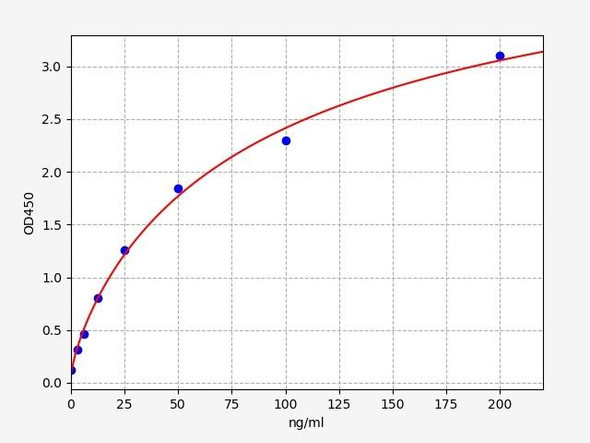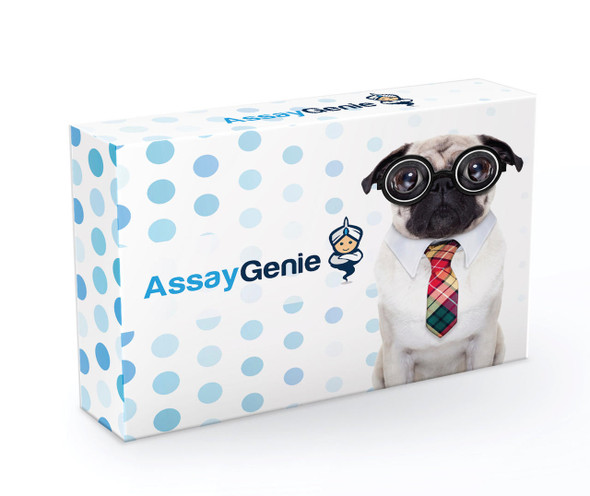Human AMPH / Anti-Amphiphysin ELISA Kit
- SKU:
- HUFI02201
- Product Type:
- ELISA Kit
- Size:
- 96 Assays
- Sensitivity:
- 18.75pg/ml
- Range:
- 31.25-2000pg/ml
- ELISA Type:
- Sandwich
- Synonyms:
- anti-AMPH
- Reactivity:
- Human
- Research Area:
- Cell Biology
Description
Human AMPH/Anti-Amphiphysin ELISA Kit
The Human Amph (Amphiphysin) ELISA Kit is specially designed for the precise measurement of amphiphysin levels in human samples such as serum, plasma, and cell culture supernatants. This kit offers exceptional sensitivity and specificity, guaranteeing accurate and consistent results, making it an excellent tool for various research purposes.Amphiphysin is a key protein involved in synaptic vesicle endocytosis, playing a critical role in neurotransmission.
Dysregulation of amphiphysin has been linked to neurological disorders such as Alzheimer's disease and multiple sclerosis. Therefore, this ELISA kit is essential for studying the role of amphiphysin in these conditions and exploring potential therapeutic interventions.Invest in the Human Amph ELISA Kit for reliable and insightful research outcomes in the field of neurobiology and beyond.
| Product Name: | Human AMPH / Anti-Amphiphysin ELISA Kit |
| Product Code: | HUFI02201 |
| Size: | 96 Assays |
| Alias: | anti-AMPH |
| Detection method: | Sandwich ELISA, Double Antigen |
| Application: | This immunoassay kit allows for the in vitro quantitative determination of Human anti AMPH concentrations in serum plasma and other biological fluids. |
| Sensitivity: | 18.75pg/ml |
| Range: | 31.25-2000pg/ml |
| Storage: | 4°C for 6 months |
| Note: | For Research Use Only |
| Recovery: | Matrices listed below were spiked with certain level of Human anti AMPH and the recovery rates were calculated by comparing the measured value to the expected amount of Human anti AMPH in samples. | ||||||||||||||||
| |||||||||||||||||
| Linearity: | The linearity of the kit was assayed by testing samples spiked with appropriate concentration of Human anti AMPH and their serial dilutions. The results were demonstrated by the percentage of calculated concentration to the expected. | ||||||||||||||||
| |||||||||||||||||
| CV(%): | Intra-Assay: CV<8% Inter-Assay: CV<10% |
| Component | Quantity | Storage |
| ELISA Microplate (Dismountable) | 8×12 strips | 4°C for 6 months |
| Lyophilized Standard | 2 | 4°C/-20°C |
| Sample/Standard Dilution Buffer | 20ml | 4°C |
| Biotin-labeled Antigen (Concentrated) | 120ul | 4°C (Protect from light) |
| Antigen Dilution Buffer | 10ml | 4°C |
| HRP-Streptavidin Conjugate(SABC) | 120ul | 4°C (Protect from light) |
| SABC Dilution Buffer | 10ml | 4°C |
| TMB Substrate | 10ml | 4°C (Protect from light) |
| Stop Solution | 10ml | 4°C |
| Wash Buffer(25X) | 30ml | 4°C |
| Plate Sealer | 5 | - |
Other materials and equipment required:
- Microplate reader with 450 nm wavelength filter
- Multichannel Pipette, Pipette, microcentrifuge tubes and disposable pipette tips
- Incubator
- Deionized or distilled water
- Absorbent paper
- Buffer resevoir
| Uniprot | P49418 |
| UniProt Protein Function: | amphiphysin: May participate in mechanisms of regulated exocytosis in synapses and certain endocrine cell types. May control the properties of the membrane associated cytoskeleton. 2 isoforms of the human protein are produced by alternative splicing. |
| UniProt Protein Details: | Protein type:Vesicle Chromosomal Location of Human Ortholog: 7p14-p13 Cellular Component: synaptic vesicle; synaptic vesicle membrane; cell junction; actin cytoskeleton Molecular Function:protein binding; phospholipid binding Biological Process: synaptic transmission; synaptic vesicle endocytosis; endocytosis; learning |
| NCBI Summary: | This gene encodes a protein associated with the cytoplasmic surface of synaptic vesicles. A subset of patients with stiff-man syndrome who were also affected by breast cancer are positive for autoantibodies against this protein. Alternate splicing of this gene results in two transcript variants encoding different isoforms. Additional splice variants have been described, but their full length sequences have not been determined. A pseudogene of this gene is found on chromosome 11.[provided by RefSeq, Nov 2010] |
| UniProt Code: | P49418 |
| NCBI GenInfo Identifier: | 1351924 |
| NCBI Gene ID: | 273 |
| NCBI Accession: | P49418.1 |
| UniProt Secondary Accession: | P49418,O43538, Q75MJ8, Q75MK5, Q75MM3, Q8N4G0, A4D1X8 A4D1X9, |
| UniProt Related Accession: | P49418 |
| Molecular Weight: | 695 |
| NCBI Full Name: | Amphiphysin |
| NCBI Synonym Full Names: | amphiphysin |
| NCBI Official Symbol: | AMPH |
| NCBI Official Synonym Symbols: | AMPH1 |
| NCBI Protein Information: | amphiphysin; amphiphysin I; amphiphysin (Stiff-Mann syndrome with breast cancer 128kD autoantigen) |
| UniProt Protein Name: | Amphiphysin |
| Protein Family: | Amphinase |
| UniProt Gene Name: | AMPH |
| UniProt Entry Name: | AMPH_HUMAN |
*Note: Protocols are specific to each batch/lot. For the correct instructions please follow the protocol included in your kit.
Bring all reagents and samples to room temperature 30 minutes before use. When diluting samples and reagents, they must be mixed completely and evenly. It is recommended to plot a standard curve for each test.
| Step | Protocol |
| 1. | Set standard, test sample (diluted at least ½ with Sample Dilution Buffer) and control (zero) wells on the pre-coated plate and record their positions. It is recommended to measure each standard and sample in duplicate. Wash plate 2 times before adding standard, sample and control (blank) wells. |
| 2. | Aliquot 100µl of standard solutions into the standard wells |
| 3. | Add 100µl of Sample / Standard dilution buffer into the control (blank) well. |
| 4. | Add 100µl of properly diluted sample (serum, plasma, tissue homogenates and other biological fluids) into test sample wells. |
| 5. | Seal the plate with a cover and incubate at 37 °C for 90 min. |
| 6. | Remove the cover and discard the plate content, clap the plate on the absorbent filter papers or other absorbent material. Do NOT let the wells completely dry at any time. Wash plate X2. |
| 7. | Add 0.1 ml of Biotin-detection antigen working solution into the above wells (standard, test sample & zero wells). Add the solution at the bottom of each well without touching the side wall. |
| 8. | Seal the plate with a cover and incubate at 37°C for 60 min. |
| 9. | Remove the cover, and wash plate 3 times with Wash buffer. Let wash buffer rest in wells for 1 min between each wash. |
| 10. | Add 0.1 ml of SABC working solution into each well, cover the plate and incubate at 37°C for 30 min. |
| 11. | Remove the cover and wash plate 5 times with Wash buffer, and each time let the wash buffer stay in the wells for 1-2 min. |
| 12. | Add 90 µl of TMB substrate into each well, cover the plate and incubate at 37°C in dark within 10-20 min. (Note: This incubation time is for reference use only, the optimal time should be determined by end user.) And the shades of blue can be seen in the first 3-4 wells (with most concentrated standard solutions), the other wells show no obvious color. |
| 13. | Add 50 µl of Stop solution into each well and mix thoroughly. The color changes into yellow immediately. |
| 14. | Read the O.D. absorbance at 450 nm in a microplate reader immediately after adding the stop solution. |
When carrying out an ELISA assay it is important to prepare your samples in order to achieve the best possible results. Below we have a list of procedures for the preparation of samples for different sample types.
| Sample Type | Protocol |
| Serum | If using serum separator tubes, allow samples to clot for 30 minutes at room temperature. Centrifuge for 10 minutes at 1,000x g. Collect the serum fraction and assay promptly or aliquot and store the samples at -80°C. Avoid multiple freeze-thaw cycles. If serum separator tubes are not being used, allow samples to clot overnight at 2-8°C. Centrifuge for 10 minutes at 1,000x g. Remove serum and assay promptly or aliquot and store the samples at -80°C. Avoid multiple freeze-thaw cycles. |
| Plasma | Collect plasma using EDTA or heparin as an anticoagulant. Centrifuge samples at 4°C for 15 mins at 1000 × g within 30 mins of collection. Collect the plasma fraction and assay promptly or aliquot and store the samples at -80°C. Avoid multiple freeze-thaw cycles. Note: Over haemolysed samples are not suitable for use with this kit. |
| Urine & Cerebrospinal Fluid | Collect the urine (mid-stream) in a sterile container, centrifuge for 20 mins at 2000-3000 rpm. Remove supernatant and assay immediately. If any precipitation is detected, repeat the centrifugation step. A similar protocol can be used for cerebrospinal fluid. |
| Cell culture supernatant | Collect the cell culture media by pipette, followed by centrifugation at 4°C for 20 mins at 1500 rpm. Collect the clear supernatant and assay immediately. |
| Cell lysates | Solubilize cells in lysis buffer and allow to sit on ice for 30 minutes. Centrifuge tubes at 14,000 x g for 5 minutes to remove insoluble material. Aliquot the supernatant into a new tube and discard the remaining whole cell extract. Quantify total protein concentration using a total protein assay. Assay immediately or aliquot and store at ≤ -20 °C. |
| Tissue homogenates | The preparation of tissue homogenates will vary depending upon tissue type. Rinse tissue with 1X PBS to remove excess blood & homogenize in 20ml of 1X PBS (including protease inhibitors) and store overnight at ≤ -20°C. Two freeze-thaw cycles are required to break the cell membranes. To further disrupt the cell membranes you can sonicate the samples. Centrifuge homogenates for 5 mins at 5000xg. Remove the supernatant and assay immediately or aliquot and store at -20°C or -80°C. |
| Tissue lysates | Rinse tissue with PBS, cut into 1-2 mm pieces, and homogenize with a tissue homogenizer in PBS. Add an equal volume of RIPA buffer containing protease inhibitors and lyse tissues at room temperature for 30 minutes with gentle agitation. Centrifuge to remove debris. Quantify total protein concentration using a total protein assay. Assay immediately or aliquot and store at ≤ -20 °C. |
| Breast Milk | Collect milk samples and centrifuge at 10,000 x g for 60 min at 4°C. Aliquot the supernatant and assay. For long term use, store samples at -80°C. Minimize freeze/thaw cycles. |









